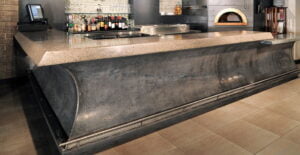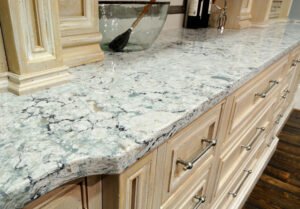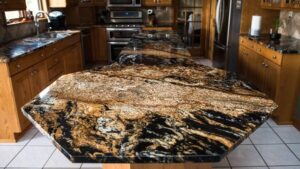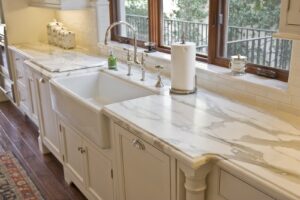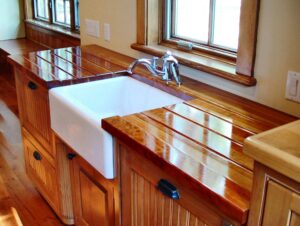Laminate kitchen countertops, sounds a bit strange, doesn’t it? In fact, such worktops are gaining popularity, but why?
Hire pressure laminate countertops or HPL countertops are basically paper-laminated plastic. The material composes of cellulose fiber layers impregnated with thermo-active resins under high pressure and temperature. It is then compressed and sintered. As the result, the finished product is a robust, homogenous material.
Pros of Laminate Countertops
Since laminate HPL is essentially fibers and resins, the finish product has high moisture resistance with sufficiently strong durable surface. This makes it suitable for use in wet areas, such as bathrooms, and kitchen. For that reason, it is a universal countertop material good for both indoors and outdoors.
Another advantage of an HPL tabletop is the ease of installation. You can simply attach a benchtop to the kitchen module from the bottom, with screws. And thanks to the self-supporting property, they accommodate various sink types. This includes, but not limited to, bottom mounting, flush mounting, and folding sinks. Even a 12mm thick laminate counter top will get away without a substrate.
Despite being eco-friendly, laminate HPL countertops have high heat resistance. Usable temperature can be up to 180 degrees Celsius (Fahrenheit), and above. These tabletops have the optimal fire safety class “km1”.
Due to the use of natural materials, laminate can be the perfect countertop choice for wooden patterns. And with a wide variety of colors and textures, it is easy to find something that suits your decor.
A laminate kitchen countertop does not require additional surface processing after cutting. All thanks to the high pressure and temperature used in production. Also, the compression and sintering process makes the worktop resistant to chemical dyes. You can wash off permanent markers with just water.
Lastly, the low cost of production makes it easy to find cheap laminate countertops. And you can verify quality by inspecting the technical passport and certificate from testing laboratories.
Cons of Laminate Countertop
HPL benchtops usually come pre-made, or cut to measurement, in blocks. This means that seams are visible when joining individual pieces.
Besides that, it is not possible to bend laminate kitchen benches. The design can only be flat straight surfaces. On top of that, dimensions must be as accurate as possible. You cannot fix sizes on the spot. Any outside interference can lead to chipping and damage the product.
Another drawback of budget laminate HPL material is fairly low resistance to scratches, chips, and bumps. So cutting on these kitchen countertops is not advised. Some of the more expensive brands, like Fenix, do have self-healing properties for micro scratches. But even they can not substitute a good old kitchen cutting board.
As mentioned earlier, you can easily install these tabletops yourself. However, cutting laminate counter holes for the sink or hob still requires professional equipment. This is because the laminate surface can easily chip without a clean cut.
Conclusions
If you have a minimalistic or modern kitchen design, then HPL may be the best laminate countertops. They come at affordable prices with relatively durable finishes. Plenty of decor options and color choices can ease your shopping experience. However, cheap countertops are prone to scratching, and you cannot easily refurbish them.


